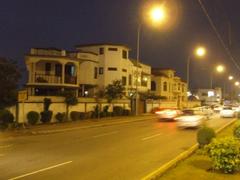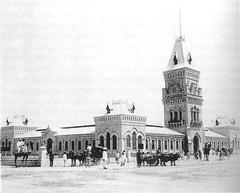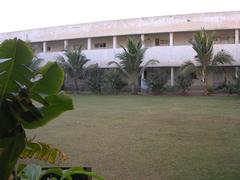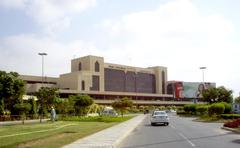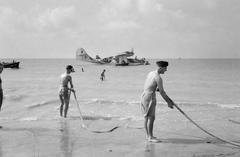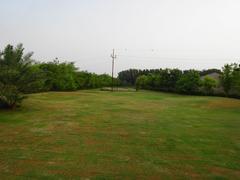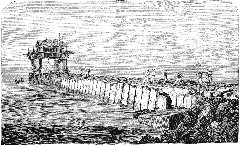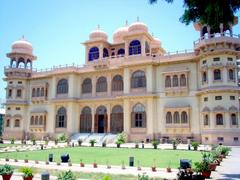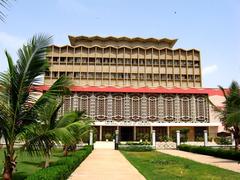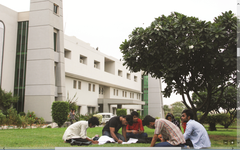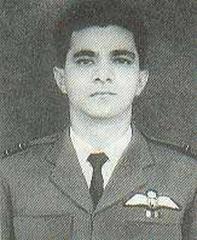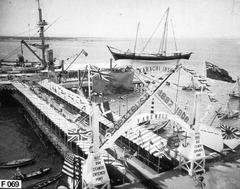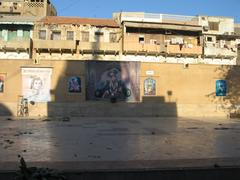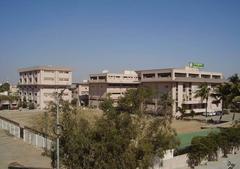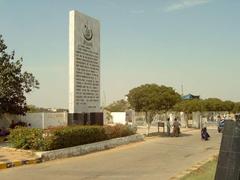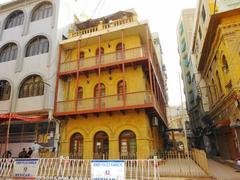Karachi Cantonment Railway Station: Visiting Hours, Tickets, and Comprehensive Visitor Guide
Date: 14/06/2025
Introduction
Karachi Cantonment Railway Station, widely known as Karachi Cantt, stands as a historic and architectural icon in Pakistan’s largest city. Established during the British colonial era, it serves not only as the busiest and most significant railway station in the country but also as a gateway connecting Karachi to the nation’s major cities. Its blend of Victorian and Indo-Saracenic architecture, strategic rail connectivity, and modern amenities make it both a vital transport hub and a fascinating destination for history enthusiasts and travelers alike. This guide provides an in-depth look at Karachi Cantt’s history, facilities, visiting hours, ticketing, accessibility, and nearby attractions (Wikipedia, IRFCA, Graana).
Contents
- Early Development and Colonial Foundations
- Architectural Significance and Design
- Expansion and Modernization
- Cultural and Historical Context
- Strategic Rail Connectivity
- Visiting Hours & Ticketing
- Facilities & Accessibility
- Transportation & Connectivity
- Nearby Attractions
- Frequently Asked Questions (FAQs)
- Safety & Travel Tips
- Summary Table: Key Facilities and Services
- Visitor Recommendations & Conclusion
Early Development and Colonial Foundations
Karachi Cantt was conceived in the mid-19th century as part of the Scinde Railway’s ambitious expansion, aiming to link Karachi with Sindh’s interior and the broader British Indian rail network. The station’s establishment was closely tied to the pioneering Karachi-Kotri railway line, inaugurated in 1861, which became the first public railway line in present-day Pakistan (Wikipedia). Strategically located in the cantonment area, the station quickly eclipsed the older Karachi City Station, becoming the city’s principal terminus and a focal point for both civilian and military transit (IRFCA).
Architectural Significance and Design
Karachi Cantt’s main building is an exemplar of Victorian and Indo-Saracenic architecture. The use of yellow Gizri sandstone, high arched windows, spacious verandas, and a prominent clock tower reflect both colonial-era aesthetics and practical considerations for Karachi’s coastal climate (Wikipedia). Internally, the station was designed with wide platforms, high ceilings for ventilation, and separate waiting areas for different passenger classes—a reflection of the era’s social hierarchies.
Expansion and Modernization
The 20th century saw Karachi Cantt undergo significant expansion to accommodate the city’s burgeoning population and freight demands. The addition of new administrative offices, reinforced concrete structures, steel roofing, and electric lighting modernized the station without compromising its historic character (pakrailway.pk). Today, with multiple platforms and extensive yards, Karachi Cantt efficiently manages both passenger and freight operations.
Cultural and Historical Context
Throughout its history, the station has been a witness to pivotal national events, most notably during the mass migrations of 1947. Its proximity to the cantonment area made it crucial for military logistics during both World Wars and in the early years of Pakistan’s independence, cementing its place in the city’s—and nation’s—collective memory (Wikipedia).
Strategic Rail Connectivity
National Rail Gateway
Karachi Cantt is the principal terminus for trains heading north from Karachi. It serves as the southern anchor of Pakistan Railways’ Main Line 1 (ML-1), connecting Karachi to Lahore, Islamabad, Peshawar, Quetta, and other major cities (umarbz.blogspot.com). The station’s infrastructure includes eight platforms and ten tracks, supporting high-capacity passenger and freight operations (medium.com).
Integration with Urban Transport
Strategically located on Dr. Daud Pota Road near Saddar, the station is integrated with Karachi’s bus rapid transit (BRT), taxi, and ride-hailing networks, ensuring seamless connectivity for millions of travelers (Samaa TV).
Karachi Circular Railway (KCR) and Regional Links
Karachi Cantt is connected to other key stations, including Karachi City Station and Drigh Road Station, and will benefit from the revival of the Karachi Circular Railway, further enhancing commuter options (Zameen).
Visiting Hours & Ticketing
- Station Hours: Open 24/7 for train operations. Ticket counters typically operate from 5:00 AM to 10:00 PM; administrative offices from 8:00 AM to 8:00 PM (pakrailway.pk).
- Ticketing: Tickets for express and local trains can be purchased at the station counters, via the Pakistan Railways e-ticketing portal (Pakistan Railways Official Website), or by calling the railway inquiries helpline at 117. Advance booking is advised during peak seasons.
- Ticket Prices: Vary by destination and class (economy to business). Check updated fares online or at the station.
Facilities & Accessibility
Passenger Amenities
- Waiting Areas: Separate lounges for families and women, equipped with comfortable seating, fans, and clean restrooms.
- Food Outlets: Options include restaurants like Pizza Hut and Rehmat-e-Shereen, plus numerous snack and tea stalls.
- Restrooms: Clean and well-maintained, with facilities for men, women, and differently-abled passengers.
- Cargo and Parcel Services: Dedicated counters and storage for both personal and commercial shipments.
Station Infrastructure
- Platforms & Capacity: Five platforms and eight tracks handle up to 56 trains daily.
- Security: 24/7 CCTV surveillance, security personnel, baggage screening, and controlled access.
- Accessibility: Ramps, handrails, accessible restrooms, and staff assistance for those with disabilities.
Additional Services
- Retail Shops: Newspapers, magazines, souvenirs, and travel essentials.
- Information Desks: Staffed by multilingual personnel for schedules, directions, and assistance.
- Lost & Found: Dedicated office for misplaced items.
- Wi-Fi & Charging: Limited free Wi-Fi and charging stations in select areas.
Transportation & Connectivity
- By Road: Located on Dr. Daud Pota Road; easily accessible by taxi, rickshaw, and public buses.
- Ride-Hailing: Services like Uber, Careem, and Bykea operate extensively in the area.
- Parking: Available but limited; public transport is recommended during peak hours.
- Airport: Jinnah International Airport is about 14–15 km away—accessible by taxi or bus in 30–60 minutes (Samaa TV).
- Intercity/Regional Trains: Frequent connections to Lahore, Peshawar, Multan, Rawalpindi, Hyderabad, Quetta, and more.
- Karachi Circular Railway: Drigh Road Station nearby serves KCR and mainline services.
Nearby Attractions
- Frere Hall: Colonial-era building and gardens, hosting cultural events (The Wandering Quinn).
- Empress Market: Iconic Victorian market for spices, textiles, and local goods (Visit in Pakistan).
- Quaid-e-Azam Mausoleum & House: Memorials to Pakistan’s founder.
- National Museum of Pakistan: Ancient artifacts and national history exhibits.
- Burns Road: Karachi’s culinary hotspot for local cuisine (Graana).
- Port Grand: Waterfront entertainment and dining destination.
Frequently Asked Questions (FAQs)
Q: What are Karachi Cantt’s visiting hours?
A: The station operates 24/7; ticket counters are open from 5:00 AM to 10:00 PM.
Q: How can I purchase tickets?
A: At station counters, online (Pakistan Railways Official Website), or via the 117 helpline.
Q: Is the station accessible for disabled passengers?
A: Yes. Ramps, handrails, accessible restrooms, and staff assistance are available.
Q: What facilities are provided?
A: Waiting rooms, restrooms, eateries, cargo services, shops, security, and information desks.
Q: What attractions are nearby?
A: Frere Hall, Empress Market, Quaid-e-Azam Mausoleum, and Port Grand.
Q: How do I reach the airport?
A: By taxi, ride-hailing, or bus via Shahrah-e-Faisal; journey takes 30–60 minutes.
Safety & Travel Tips
- Keep valuables secure and tickets handy.
- Book in advance, especially during holidays.
- Arrive at least 30 minutes before departure.
- Use official transport and avoid isolated areas at night.
- Seek help from uniformed staff or at information desks if needed.
Summary Table: Key Facilities and Services
| Facility/Service | Details |
|---|---|
| Ticketing | On-site counters, online booking, helpline (117) |
| Waiting Areas | Lounges for families and women, comfortable seating |
| Food & Refreshments | Restaurants (Pizza Hut, Rehmat-e-Shereen), snack kiosks |
| Restrooms | Clean, accessible, for all passengers |
| Cargo/Parcel | Dedicated counters, staff assistance |
| Security | CCTV, security staff, baggage screening |
| Accessibility | Ramps, handrails, accessible restrooms, staff help |
| Connectivity | Taxis, buses, rickshaws, ride-hailing, parking, airport access |
| Retail | Magazines, essentials, souvenirs |
| Information | Help desks with multilingual staff |
| Lost & Found | Dedicated office |
| Wi-Fi/Charging | Limited availability in select areas |
Visitor Recommendations & Conclusion
Karachi Cantonment Railway Station is not just a bustling transit point—it is a living monument to Karachi’s architectural, cultural, and economic evolution. Whether you are traveling, sightseeing, or exploring the city’s colonial heritage, Karachi Cantt offers a blend of history, convenience, and modern amenities (pakrailway.pk, umarbz.blogspot.com). For a rewarding visit:
- Book tickets in advance using Pakistan Railways Official Website or the 117 helpline.
- Explore nearby historical and culinary attractions.
- Use public transport or ride-hailing for convenient access.
- Check for special heritage events or tours.
For more insights and travel planning, check out the following resources:
Further Reading & Official Resources:
- Karachi City railway station, Wikipedia
- Karachi-Kotri Railway History, IRFCA
- Five Largest and Busiest Railway Stations in Pakistan, umarbz.blogspot
- Karachi Railway Station Overview, Zameen
- Everything You Need to Know About Karachi Railway Station, Graana
- Karachi Transport System Major Update, Samaa TV
- Top 10 Railway Stations in Pakistan, Medium
- Pakistan Railways Official Website
Plan your journey today and experience the intersection of history, architecture, and modern travel at Karachi Cantt.
